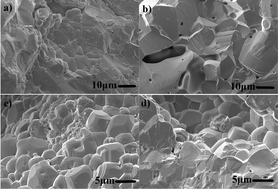Functional properties of donor- and acceptor-co-doped high dielectric constant zinc oxide ceramics
Abstract
In this work we investigated the functional properties of a set of acceptor (Cu1+) and donor (Gd3+) codoped wurtzite ZnO ceramics Zn(1−x)(CuzGdy)xO for x = 0.01 synthesized by the pressure-less solid state sintering method. XRD and optical measurements established the substitution of dopant ions into zinc lattice sites directly. The co-doping process influenced the creation of oxygen vacancies which modified their electronic properties and decreased the band gap energy. The existence of such defects leads to non-radiative decay, which caused different electronic recombination in the luminescence emission. The samples exhibited a high dielectric constant (>= ∼103) with an acceptable low dielectric loss (tan δ ∼ 10−1) in the frequency range 10–103 Hz. The dielectric results were discussed in terms of different polarization effects that may be present in the lattice such as polaron-like electron transport/hopping, defect dipoles, and barrier layer capacitance effects. The presence of both donor (Gd3+) and acceptor (Cu1+) ions in ZnO decreased the dielectric loss in the materials and the most favorable balance between high dielectric constant and low dielectric loss properties was found. Impedance analysis ruled out any contribution from electrode–grain interfaces to the high-K (high dielectric constant) properties in pure and doped zinc oxide ceramics. The correlation between the physical properties studies are a guideline in the classificatory understanding of semiconductor materials.

- This article is part of the themed collection: Celebrating Latin American Talent in Chemistry


 Please wait while we load your content...
Please wait while we load your content...